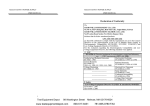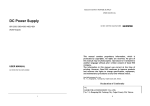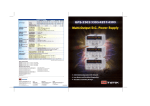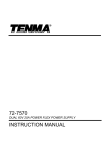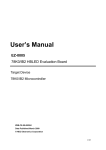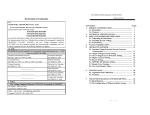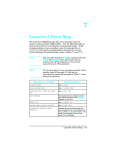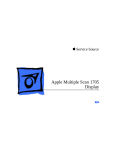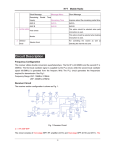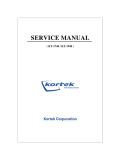Download IPS 2303, 3303, 4303 Series USER MANUAL
Transcript
IPS 2303, 3303, 4303 Series USER MANUAL IPS 2303, 3303, 4303 Series USER MANUAL SAFETY TERMS AND SYMBOLS SECTION PAGE 1. INTRODUCTION........……………………………………………. 1 2. SPECIFICATIONS………………………………………..………. 2 2-1 General…………………………………………………………. 2 2-2 Operation Mode……………………………………………….. 2 2-3 Constant Voltage Operation…………………………………... 2 2-4 Constant Current Operation………………………………….. 3 2-5 Tracking Mode………………………………………………… 3 2-6 Meter………………………………………….………………... 3 2-7 CH3 Output Specification……………………………………... 3 2-8 CH4 Output Specification……………………………………... 3 2-9 Insulation………………………………………………………. 3 3. THEORY OF OPERATION..…………………………………….. 4 4. PANEL CONTROLS AND INDICATORS...........………………. 6 4-1 Front Panel…………………………………………………….. 8 4-2 Real Panel………………………………………….…………... 10 5. OPERATION INSTRUCTIONS…………………….…………… 11 5-1 Precautions……..…………………………………….………... 11 5-2 Setting Current Limit…………………………………………. 11 5-3 Constant Voltage/ Constant Current Characteristics..……… 12 5-4 Operation Mode……………………………………………….. 13 6. MAINTENANCE…......……………………………………...……. 19 6-1 Fuse Replacement……………………………………………… 19 6-2 Line Voltage Conversion………………………………………. 19 6-3 Adjustments……………………………………………………. 20 6-4 Cleaning………………………………………………………... 24 Please take a moment to review these safety terms and symbols, which may appear in this manual or on Equipment. This may prevent injury or harm to users, or damage to equipment. WARNING. Warning statements identify conditions or practices that could result in injury or loss of life. CAUTION. Caution statements identify conditions or practices that could result in damage to this instrument or other equipment. DANGER! High Voltage ATTENTION! refer to Manual Protective Conductor Terminal (ground) Earth Terminal Frame or Chassis Terminal i ii IPS 2303, 3303, 4303 Series USER MANUAL IPS 2303, 3303, 4303 Series USER MANUAL FOR UNITED KINGDOM ONLY 1. INTRODUCTION NOTE: This lead/appliance must only be wired by competent persons WARNING: THIS APPLIANCE MUST BE EARTHED IMPORTANT: The wires in this lead are coloured in accordance with the following code: Green/ Yellow: Earth Blue: Neutral Brown: Live(Phase) As the colours of the wires in main leads may not correspond with the colours marking identified in your plug/appliance, proceed as follows: The wire which is coloured Green & Yellow must be connected to the Earth terminal marked with the letter E or by the earth symbol or coloured Green or Green & Yellow. The wire which is coloured Blue must be connected to the terminal which is marked with the letter N or coloured Blue or Black. The wire which is coloured Brown must be connected to the terminal marked with the letter L or P or coloured Brown or Red. If in doubt, consult the instructions provided with the equipment, the supplier or a competent electrician. This cable/appliance should be protected by a suitably rated and approved HBC mains fuse: refer to the rating information on the equipment and/or user instructions for details. As a guide, cable of 0.75mm² should be protected by a 3A or 5A fuse. Larger conductors would normally require 13A types, depending on the connection method used. Any moulded mains connector that requires removal / replacement must be destroyed by removal of any fuse & fuse carrier and disposed of immediately, as a plug with bared wires is hazardous if a engaged in live socket. Any re-wiring must be carried out in accordance with the information detailed on this label. iii The regulated DC power supply series is designed to be used in applications such as powering operational amplifiers, push-pull stages, logic circuits and systems where plus and minus voltages are required to track with an insignificant error. To provide operating convenience, the IPS-4303 has four independent power supplies (while the IPS-2303 has two and IPS-3303 has three) housed in a single package. The IPS-4303 consists of four identical, independent, adjustable DC power supplies (while two for the IPS-2303 and three for IPS-3303). A front panel switch selects one of three operation modes of independent, series and parallel. In the independent mode, the output voltage and current of each supply are controlled separately, and each supply is isolated up to 300V from output to chassis or output to output. In the tracking mode, both outputs are automatically connected in series or parallel, and the controls of the left supply adjust the magnitudes of both the positive and negative output voltages. Because the outputs are connected in a tracking configuration, any internal disturbance in the master supply (such as drift or ripple) will cause an equal change in the outputs of both the supplies. Each power supply (except CH3 for the IPS-3303 and CH4 for the IPS-4303) is a completely transistorized, well-regulated, constant voltage/constant current supply that will provide full rated output voltage at the maximum output current or can be continuously adjusted throughout the output range. The front panel current controls can be used to establish the output current limit (overload or short circuit) when the supply is used as a constant voltage source (independent or tracking modes) and the voltage controls can be used to establish the voltage limit (ceiling) when the supply is used as a constant current source (independent mode only). The supply will automatically cross over from constant voltage to constant current operation (current limited operation in the tracking mode). Each power supply (CH1~CH4) has its own front panel meter that can measure output voltage or current. One power supply may be used as a CH1 supply controlling, one CH2 supplies furnishing various voltage or current for a system. When operate with the front panel mode switch in the tracking position, the instrument is automatically internally connected in auto-tracking configuration. For audio production line use, the continuous or dynamic load can be internally selected. When the connector (J111&J309) is connected to “ON” position the unit is suitable for audio power Amplifier application (Normal setting to “OFF” position). 1 IPS 2303, 3303, 4303 Series USER MANUAL 2. SPECIFICATIONS 2-1. General Main Supply (switch selectable) Operation Environment Storage Temperature & Humidity Accessories : 100V/120V/220V ± 10%(230V +10%~-6%) 50/60Hz. : Indoor use. Altitude up to 2000m. Ambient temperature 0℃ to 40℃. Relative humidity 80% (maximum). Installation category II. Pollution degree 2. : -10℃ to 70℃.70% (maximum). : Operation Manual ×1. Table 2-1: Model IPS-2303 IPS-3303 IPS-4303 OUTPUT Independent 0~30V×2 0~3A×2 0~30V×2 0~3A×2 0~30V×2 0~3A×2 Dimensions Weight (kg) 2-2. Operation Mode (1) Independent (2) Series (3) 2-3. (1) (2) Series 60V 3A 60V 3A 60V 3A Para 30V 6A 30V 6A 30V 6A REPLACEMENT FUSE RATED INPUT TEST LEADS TYPE(20×5mmHBC) 100V/120V 220V/230V WATTS VA (QTY) T6A T3.15A 350 450 2 250V 250V T6.3A T3.15A 420 550 3 250V 250V T6.3A T3.15A 420 550 4 250V 250V : 255(W) ×145(H) ×265(D) m/m : 7.0 kg. : Two independent outputs and CH3: 2.2~5.2V output for IPS-4303, Fixed 5V for IPS-3303, CH4: 8~15V output for IPS-4303. Output from 0 to rated voltage and 0 to rated current. : Output from 0 to rated voltage at rated current each. : Output from 0 to twice rated voltage at rated current. : Output from 0 to twice rated current at rated volts. Parallel Constant Voltage Operation Output voltage range : 0 to rated voltage, continuously adjustable. Regulation : Line regulation≦0.01% + 3mV. : Load regulation≦0.01%+3mV(rated current≦3A). : Load regulation≦0.02%+5mV (rated current>3A). (3) Recovery time : ≦100μs (50% load change, minimum load 0.5A ). (4) Ripple & Noise : ≦1mVrms (5Hz-1MHz ). (5) Temperature coefficient : ≦300ppm/℃. 2 IPS 2303, 3303, 4303 Series USER MANUAL 2-4. Constant Current Operation (1) Output current range : 0 to rated current continuously adjustable. (2) Regulation : Line regulation≦0.2% + 3mA. : Load regulation≦0.2% +3mA. (3) Ripple current : ≦3mArms. 2-5. Tracking Operation (1) Parallel Operation Regulation : Line regulation≦0.01% + 3mV. : Load regulation≦0.01%+3mV (rating current≦3A). ≦0.02%+5mV (rating current >3A). (2) Series Operation Regulation : Line regulation≦0.01%+5mV. : Load regulation≦300mV. A. Positive and Negative supply (Fig 5-4) CH2 tracking error ≦0.5%+10mV of the CH1 (No load, with load add load regulation≦300mV) B. Single supply (Fig. 5-3) 2-6. Meter A. Display A : 3 digits panel meter×2 (0.5” Red LED display). Display V : 3 digits panel meter × 2 (0.5” Green LED display). B. Accuracy : OUTPUT ON±(0.5% of rdg + 2 digits) : OUTPUT OFF±(0.5% of rdg + 8 digits)(not for IPS-2303) C. Voltmeter : 99.9V full scale. D. Ammeter : 9.99A full scale. 2-7. CH3 Output Specifications (1) Regulation : Line regulation≦5mV, load regulation≦15mV. (2) Ripple & Noise : ≦2mVrms. (3) Output Voltage range : IPS-4303: 2.2~5.2V±8% continuous adjustment. IPS-3303 fixed 5V±8% continuous adjustment. (4) Output current : 3A for IPS-3303, 1A for IPS-4303. 2-8. CH4 Output Specifications (1) Regulation : Line regulation≦5mV, load regulation≦10mV. (2) Ripple & Noise : ≦2mVrms. (3) Output Voltage range : IPS-4303: 8~15V±8% continuous adjustment. (4) Output current : 1A 2-9. Insulation Between chassis and output terminal : 20MΩ or above (DC 500V). Between chassis and AC cord : 30MΩ or above (DC 500V). 3 IPS 2303, 3303, 4303 Series USER MANUAL IPS 2303, 3303, 4303 Series USER MANUAL 3. THEORY OF OPERATION The power supply consists of an AC input circuit and transformer; a bias supply consisting of an rectifier, filter, pre-regulator and reference voltage source; a main regulator circuit consisting of the main rectifier and filter, a series regulator, a current comparator, a voltage comparator, a reference voltage amplifier and a relay control circuit. The circuit element consists of integrated circuit U101, U102, U103, U104, U105, U108. The circuit arrangement is shown as block diagram in Fig. 3-1. The circuitry is discussed with reference to the block diagram function description. Single phase input power is applied to the transformer through the input circuit. Auxiliary rectifier D1021~1024 provides a bias voltage which is filtered by capacitor C103 and C104 for the pre-regulator. U101, U108 provides a regulator voltage for the active components. The main rectifier is a full wave bridge that provides the power which is filtered by capacitor C1021, then regulated via a series regulator and delivered to the output. U105 acts as a current limiter. When the output current is over predetermined value, U105 is activated and reduces the output. U102 provides a reference voltage for U103 and U105. U103 is an inverting amplifier. U104 compares a reference voltage and feedback voltage, drives Q103 and Q104, which then calibrate the output voltage. Q113 is activated when the unit is overloaded. It controls the current magnitude of Q103, which limits the output current. The relay control circuit provides limited power dissipation in the series regulator. 4 Figure 3-1 Block Diagram 5 IPS 2303, 3303, 4303 Series USER MANUAL IPS 2303, 3303, 4303 Series USER MANUAL 4. PANEL CONTROLS AND INDICATORS Fig. 4-1 Front Panel 6 Fig. 4-2 Real Panel 7 IPS 2303, 3303, 4303 Series USER MANUAL 4-1. Front Panel (1) Power switch : Turns the power input ON/OFF (2) Meter V : Indicates the CH1 or CH3 output voltage. (3) Meter A : Indicates the CH1 or CH3 output current. (4) Meter V : Indicates the CH2 or CH4 output voltage. (5) Meter A : Indicates the CH2 or CH4 output current. (6) Voltage Control : Adjusts the output voltage of the CH1 supply. Also the adjustment control for the maximum output voltage of the CH2 supply when in either parallel or series tracking mode. (7) Current Control : Adjusts the output current of the CH1 supply, Also the adjustment control for the maximum output current of the CH2 supply when in either parallel or series tracking mode. IPS 2303, 3303, 4303 Series USER MANUAL (15) CV&CC Indicator : The CV light (green LED) is on when the CH1 supply is in constant voltage mode, or when both the CH1 and CH2 supplies are in constant voltage mode in either series or parallel tracking mode. : The CC light (red LED) is on when the CH1 supply is in constant current mode. (16) CV&CC Indicator : The CV light (green LED) is on when the CH2 supply is in constant voltage mode. : The CC light (red LED) is on when the CH2 supply is in constant current mode or in parallel tracking mode. (17) Overload Indicator : Lights when CH4 output load is larger than rated value (not IPS-2303 & 3303). (18) Output Indicator : Lights when the output is turned on. (19) + output terminal : Positive polarity output terminal for the CH3 supply (not IPS-2303). (8) Voltage Control : Adjusts the output voltage of the CH2 supply when in independent operation. (20) - output terminal : Negative polarity output terminal for the CH3 supply (not IPS-2303). (9) Current Control : Adjusts the output current of the CH2 supply. (21) + output terminal : Positive polarity output terminal for the CH1 supply. (10) Voltage Control : Adjusts the output voltage of the CH3 supply (not IPS-2303 & 3303). (22) - output terminal : Negative polarity output terminal for the CH1 supply. (11) Voltage Control : Adjusts the output voltage of the CH4 supply (not IPS-2303 & 3303). (23) GND terminal : Earth and chassis ground. (24) + output terminal : Positive polarity output terminal for the CH2 supply. (25) - output terminal : Negative polarity output terminal for the CH2 supply. (26) + output terminal : Positive polarity output terminal for the CH4 supply (not IPS-2303 & 3303). (27) - output terminal : Negative polarity output terminal for the CH4 supply (not IPS-2303 & 3303). (28) Output switches : Turns the output ON/OFF. (12) CH1/CH3 select switch : Selects CH1 or CH3 output voltage or current (not IPS-2303 & 3303). (13) CH2/CH4 select switch : Selects CH2 or CH4 output voltage or current (not IPS-2303 & 3303). (14) Overload Indicator : Lights when CH3 output load is greater than rated output (not IPS-2303). 8 9 IPS 2303, 3303, 4303 Series USER MANUAL (29) TRACKING & Mode Switches (30) Two push-button switches that select Independent mode, series tracking mode, or parallel tracking mode as follows: a. When both switches are disengaged (out), the unit is in the Independent mode and the CH1 and CH2 power supplies are completely independent from each other. b. When the left switch is engaged (in) and the right switch is disengaged (out), the unit is in the series Tracking mode. Maximum voltage of both supplies is set using the CH1 VOLTAGE controls (voltage at output terminals of the CH2 supply tracks the voltage at the output terminals of the CH1 SUPPLY). Also, in this mode of operation, the positive terminal (Red) of the CH2 supply is connected to the negative terminal (Black) of the CH1 supply to allow the two supplies to be used as a 0 to double rated voltage supply. c. When both switches are engaged (in), the unit is in the Parallel Tracking mode. The control of both CH1 and CH2 supplies are internally linked and the maximum current and voltage for both channels are set using the CH1 controls. The CH1 and CH2 output can be used as two individual (but tracking) power supplies, or just the CH1 output can be used as a 0 to rated voltage supply with a 0 to double rated current capability. (32) Power socket : Contains the 20 x 5 mm HBC fuse of the appropriate rating, depending on the line voltage selected. : IEC inlet socket to connect to the power cable. (33) AC selector switch : Used to select operation from 100, 120, 220 or 230VAC, & 50/60Hz line voltage in conjunction with (34) HI-LO switch. (34) HI-LO switch : HI position selects high voltage range (120, 230V AC inputs), LO position selects low voltage range (100, 220V AC inputs). (35) Cooling Fan 5. OPERATION INSTRUCTION 5-1. Precaution (1) AC input AC input should be within the range of line voltage ± 10% (230V +10%~-6%) 50/60Hz. WANING. To avoid electrical shock, the power cord protective grounding conductor must be connected to ground. (2) Installation Avoid using the supply in a place where ambient temperature exceeds 40℃. The fan grille at the rear of the supply must have sufficient space to allow air to flow unimpeded. CAUTION. To avoid damaging the power supply, do not use it in a place where ambient temperature exceeds 40℃. 4-2. Real Panel (31) Fuse holder IPS 2303, 3303, 4303 Series USER MANUAL : Provides forced ventilation for the internal components, to prevent output stage from overheating and improves the stability of the output due to temperature changes. 10 (3) Output voltage overshoot Voltage at the output terminals never exceeds the preset value when the power is turned on or off. 5-2. Setting Current Limit (1) Determine the maximum safe current for the device to be powered. (2) Temporarily short the (+) and (-) terminals of the power supply together with a test lead. (3) Rotate the VOLTAGE control away from zero sufficiently for the CC indicator to light. (4) et the meter selection switch to “A” position to select the current metering mode. (5) Adjust the CURRENT control for the desired current limit. Read the current value on the Ammeter. (6) The current limit (overload protection) has now been preset. Do not change the CURRENT control setting after this step. (7) Remove the short between the (+) and (-) terminals and connect for constant voltage operation. 11 IPS 2303, 3303, 4303 Series USER MANUAL 5-3. Constant Voltage/Constant Current Characteristics The operating principle of these Power Supplies is a of constant voltage/constant current type, with automatic crossover from one mode to the other. This permits continuous transition from constant current to constant voltage modes in response to load changes. The intersection point of the constant voltage and constant current modes is known as the crossover point. Fig. 5-1 shows the relationship between this crossover point and the load. For example, if the load is such that the power supply is operating in the constant voltage mode, a regulated output voltage is provided. The output voltage remains constant as the load increases, up until the point where the preset current limit is reached. At that point, the output current becomes constant and the output voltage drops in proportion to further increases in load. The crossover point is indicated by the front panel LED indicators. The crossover point is reached when the CV (Green LED) indicator goes off and the CC (Red LED) indicator comes on. Fig. 5-1 Constant Voltage/Constant Current Characteristic Similarly, crossover from the constant current to the constant voltage mode automatically occurs from a decrease in load. A good example of this would be seen when charging a 12 volt battery. Initially, the open circuit voltage of the power supply may be preset for 13.8 volts. A low battery will place a heavy load on the supply and it will operate in the constant current mode, which may be adjusted for a 1 amp charging rate. As the battery becomes charged, and its voltage approaches 13.8 volts, its load decreases to the point where it no longer demands the full 1 amp charging rate. This is the crossover point where the power supply goes into the constant voltage mode. 12 IPS 2303, 3303, 4303 Series USER MANUAL 5-4. Operation Mode (1) Independent Operation The “CH1” and “CH2” supplies each provides a 0 to rated voltage output at up to rated current. This procedure covers the use of the CH1 and CH2 supplies, only when they are used independently from each other. When used in the independent operating mode, the operation controls of the two power supplies are completely independent and either supply can be used individually or both can be used simultaneously. A. Disengage both Tracking mode switches (both switches out) so that the power supply is in the independent operating mode. B. Adjust “Voltage” control and “Current” control to the desired output voltage and current. C. Turn off the power supply and the equipment whilst making connections.. D. Connect the positive connection of the device being powered to the red (+) terminal of the power supply. E. Connect the negative connection of the device being powered to the black (-) terminal of the power supply. F. Fig.5-2 illustrates the connection procedure. Power Supply Fig. 5-2 Independent Operation 13 IPS 2303, 3303, 4303 Series USER MANUAL (2) Series Tracking Operation When the series tracking mode of operation is selected, the position (Red) terminal of the CH2 supply output is internally connected to the negative (black) terminal of the CH1 supply. In series tracking mode, the maximum output voltage of both CH1 and CH2 supplies can be simultaneously varied with one control. The maximum CH2 supply voltage is automatically set to the same as the CH1 supply by using the CH1 VOLTAGE controls. A. Set the power supplies to the Tracking series mode by engaging the left Tracking switch and release the right Tracking switch. IPS 2303, 3303, 4303 Series USER MANUAL rotated fully clockwise and the CH2 CURRENT control can be used to adjust the maximum current value. Because current through the two supplies must be equal when they are being used in series, the lowest CURRENT control setting will set the maximum output current. C. Adjust the output voltage to the desired level by using the CH1 VOLTAGE controls. D. Turn off the power supply and the equipment whilst making connections. E. If “single supply” operation is required, this allows the power supply to be used at twice the voltage and rated current simply by using the negative (black) terminal of the CH2 supply and the positive (red) terminal of the CH1 supply, the configuration as shown in Fig. 5-3. WARNING. Voltages greater than 60V DC present a lethal shock hazard to the user. Take care when connecting power supplies in series to achieve voltages higher than 60V DC total, or 60V DC between any connection and earth ground. Note: Power Simultaneous metering of both current and voltage can be obtained in this mode of operation by setting one of the displays for current metering and one for voltage metering. In this case, the output voltage (across the two supplies) is actually double the displayed value. For example, if the CH1 display is set for voltage metering and the CH2 display for current metering, the output voltage across the CH1 positive (red) terminal and the CH2 negative (black) terminal would be double the reading on the CH1 LED Display (since both supplies are providing the same voltage). The actual output current would be the value read from the CH2 LED Display (since the two supplies are connected in series, current flowing through each supply must be equal). B. Set the CH2 CURRENT control to the full clockwise position. The maximum current is set by using the CH1 CURRENT control. Follow the instructions for “Setting Current Limit” (select “CH1” or “CH2” supply independently by using the CH1 CURRENT control). Note: Because the supplies are being used in series, either CURRENT control can be used to set maximum current. If desired, the CH1 CURRENT control can be Supply 14 Fig. 5-3 Single Supply F. If the chassis or common of the equipment being powered is separated from both the positive and negative power input connections, the output of the CH2 (negative) supply tracks the output of the CH1 (positive) supply,. The configuration is shown in Fig. 5-4. Power Supply Fig. 5-4 Positive and Negative Supply 15 IPS 2303, 3303, 4303 Series USER MANUAL IPS 2303, 3303, 4303 Series USER MANUAL (3) Parallel Tracking Operation In the parallel tracking mode of operation, both supplies are connected together (in parallel). This allows for a rated voltage supply with double the rated current capability. Only the CH1 output terminals are used for parallel tracking operation. In the parallel tracking mode, the CH2 supply output voltage and current track the CH1 supply output voltage and current. A.Set the power supplies to the Tracking Parallel mode by engaging both Tracking switches. B.The output voltage will now be read from the CH1 VOLTAGE display. Output current is exactly double the value read from the CH1 CURRENT display (because each supply is providing the same amount of current). C.Because both voltage and current of the CH2 supply track the CH1 supply, the maximum current and voltage are set by using the CH1 controls. Using the CH1 supply output terminals, follow the instructions for “Setting Current Limit” (Section 5-2). Remember that the actual current output at the CH1 supply output terminals is double the reading on the CH2 indicator meter. D.Adjust the output voltage to the desired level by using the CH1 VOLTAGE controls. E. Turn off the power supply and the equipment to be powered whilst making connections. F. Connect the positive connection of the device being powered to the red (+) terminal of the CH1 power supply. G. Connect the negative connection of the device being powered to the black (-) terminal of the CH1 power supply. The configuration is shown as Fig. 5-5: (4) CH3 Power Supply Operation The CH3 supply provides a 2.2~5.2V(IPS-4303) DC output with a 3 amps (IPS-3303) and 1 amp (IPS-4303) current capacity. The supply is ideal for us with TTL circuits (IPS-3303 5V Fixed). A. Turn off the power supply and the equipment whilst making connections. B. Connect the positive connection of the device being powered to the red (+) terminal of the CH3 supply. C. Connect the negative connection of the device being powered to the black (-) terminal of the CH3 supply. D. If the red OVERLOAD indicator lights, an excessive load has been placed on the supply. This will cause the output voltage and current to drop and inhibit the proper operation of the CH3 supply. To correct this situation, the load on the supply must be decreased so that no more than 3 amps (IPS-3303), or 1amp (IPS-4303) of current is drawn. (5) CH4 Power Supply Operation The CH4 supply provides a 8~15V(IPS-4303) DC output with a 1 amp current capacity. A.Turn off the power supply and the equipment to be powered whilst making connections. B. Connect the positive connection of the device being powered to the red (+) terminal of the CH4 supply. C. Connect the negative connection of the device being powered to the black (-) terminal of the CH4 supply. D. If the red OVERLOAD indicator lights, an excessive load has been placed on the supply. This will cause the voltage and current to drop and inhibit proper operation of the CH4 supply. Under this situation, the load on the supply must be decreased so that no more than 1 amps of current is drawn. (6) Dynamic Load Operation & Application A. When select to the dynamic load position, the peak current available is 1.7 times the rated current. This feature is only intended for audio circuits of amplifiers and audio production lines. Change the position of wafers J111 of CH1 and J309 of CH2 from “OFF” to “ON”. Please refer to Fig.6-1: Adjustment Location. Power Supply Fig. 5-5 Parallel Tracking Operation 16 17 IPS 2303, 3303, 4303 Series USER MANUAL B. For other application and testing (Safety or CE. etc.), the selectors must be set at the “OFF” position (7) Output ON/OFF Action The output ON/OFF action is controlled with a single control. When the output switch is pushed on, the single output turns on and output LED is lit. While the output switch is pushed off, or the tracking switch is on, the output will be disabled. IPS 2303, 3303, 4303 Series USER MANUAL 6. MAINTENANCE WARNING The following instructions are for use by qualified personnel only. To avoid electrical shock, do no perform any servicing other than the operation instruction of this manual unless you are qualified to do so. CAUTION: The output terminals are for use only with the equipment which has no accessible live parts. The output terminals should not be connected to any hazardous live parts. (8) Fan Control 1) The fan of the power supply will not work upon power on until the temperature of the heat sink rises up to 32℃±5℃ after adding load to output terminal. The more the temperature of the heat sink rises, the more the rolling speed of the fan gets fast. The fastest rolling speed is when the temperature reaches to 70℃. 2) To avoid damaging the power supply, if the fan fails to work when the temperature reached to the appropriate value, turn off the instrument and check the cause. 18 6-1. Fuse Replacement If the fuse blows, the CV or CC indicators will not light and the power supply will not operate. The fuse should not normally fail unless a problem has developed in the unit. Try to determine and correct the cause, then replace only with a fuse of the correct rating and type. The fuse is located on the rear panel (see Fig.4-2 & Table 2-1). WARNING: For continued fire protection, replace the fuse with 250V fuse of the specified type and rating only. Disconnect power cord before replacing fuse. 6-2. Line Voltage Conversion The primary winding of the power transformer is tapped to permit operation from 100, 120, 220, or 230VAC, 50/60Hz line voltage. Conversion from one line voltage to another is achieved by changing the AC selector switch as shown in Fig. 4-2. The rear panel identifies the line voltage to which the unit was factory set. To convert to a different line voltage, perform the following procedure: (1) Make sure the power cord is unplugged. (2) Change the AC selector switch to the desired line voltage position. (3) A change in line voltage may also require a corresponding change of fuse value. Install the correct fuse value as listed on rear panel. 19 IPS 2303, 3303, 4303 Series USER MANUAL 6-3. Adjustments This unit was accurately adjusted at the factory before shipment. Readjustment is recommended only if repairs have been made in a circuit affecting adjustment accuracy, or if you have a reason to believe the unit is out of adjustment. The recommended calibration device is a 4+1/2 digit digital multimeter with an accuracy of ±0.1% DCV or better If readjustment is required, use the following procedure. The location of the adjustments is shown in Fig. 6-1. (1) Independent Adjustment A. Disengage both Tracking mode switches (both switches out) so that the power supply is in the independent operating mode. B. Connect the multimeter to measure the DC voltage at the output terminals of the CH1 (CH2) supply. C. Set the CH1 (CH2) VOLTAGE control to maximum (fully clockwise). D. Adjust trimmer potentiometer (VR101 CH1,VR301 CH2) on the circuit board (located on the right side of the supply) for a reading as close to rated output voltage ×1.05 (on the multimeter) as possible. E. Set output on. Adjust the trimmer potentiometer (VR801 CH2, VR201 CH1) from the CH1 (CH2) on the voltage indicator circuit board (located on the meter or A/D converter board) for a reading of rated output voltage ×1.05 on the CH1 (CH2). F. Set output off. Adjust trimmer potentiometer (VR802 CH2, VR202 CH1) from the CH1 (CH2)on the voltage indicator circuit board (located on the meter or A/D converter board) for a reading of rated voltage on the CH1 (CH2)(not IPS-2303) G. Connect the multimeter across the CH1 (CH2) SUPPLY output terminals to read the output current (so that the meter causes a short circuit across the terminals) and adjust the CH1 (CH2) CURRENT control so that rated amps is read on the multimeter. H. Set output on and adjust the trimmer potentiometer (VR901 CH2, VR701 CH1) so that the CH1(CH2) meter also reads rated amps. I. Rotate the CH1(CH2) current control fully clockwise (maximum). J. Adjust VR103 on the CH1 (VR303 CH2)supply circuit board (located on the right side of the supply) to obtain an output current of rated amps × 1.05 (read on the meter or LED display). K. Set output off and adjust the trimmer potentiometer (VR903 CH2, VR703 CH1) so that the CH1(CH2) meter also reads rated amps (not IPS-2303). 20 IPS 2303, 3303, 4303 Series USER MANUAL (2) Series Tracking Adjustment A. Set the supply to Tracking series mode by engaging the left Tracking switch and releasing the right tracking switch. B. Set the CH2 CURRENT control to midrange and set the CH1 supply voltage controls to minimum (fully counterclockwise). C. Connect the multimeter to the CH1 SUPPLY outputs and measure the voltage. D.Disconnect the multimeter from the CH1 supply outputs and connect it across the CH2 supply outputs. E. Adjust trimmer potentiometer VR306 on the circuit board (located on the right side of the supply) to obtain the exact same reading for the CH2 supply output as was preset at the CH1 supply output (e.g., if the minimum CH1 supply output voltage is –10.00mV adjust VR306 to obtain an output voltage as close to -10.00mV at the CH2 supply as possible). F. Set the CH2 CURRENT control to midrange and set the CH1 supply voltage controls to maximum (fully clockwise). G. Connect the multimeter to the CH1supply outputs and measure the voltage. H. Disconnect the multimeter from the CH1supply outputs and connect it across the CH2 supply outputs. I. Set output on by adjusting VR501 (located at the left of the lower front panel circuit board, VOLTAGE/CURRENT CONTROL potentiometer board) until the voltage read from the multimeter is the same as it was across the CH1 output terminals. Return the multimeter to the CH1 output terminals and verify that the output voltage is identical. If not, repeat this step. J. Set output off by adjusting VR804 (located at the left of the lower front panel circuit board, VOLTAGE/CURRENT CONTROL potentiometer board) until the voltage read from the multimeter is the same as it was across the CH1 output terminals. Return the multimeter to the CH1 output terminals and verify that the output voltage is identical. If not, repeat this step (not IPS-2303). 21 IPS 2303, 3303, 4303 Series USER MANUAL (3) Parallel Tracking Adjustment A. Disengage both Tracking mode switches (both switches out) so that the power supply is in the independent operating mode. B. Set the CH1 supply VOLTAGE and CURRENT controls to minimum (fully counterclockwise). C. Connect the multimeter across the CH1 supply output terminals and measure the output current. D. Set the CH1 supply VOLTAGE control to midrange and adjust the CURRENT control to obtain an output current of rating amps (read on the multimeter). Do not change the CURRENT control setting after this step. E. Engaged both Tracking mode switches (both switches in), so that the power supply is in the parallel operating mode. F. Set the CH2 supply CURRENT control to maximum (fully clockwise) and set the VOLTAGE control to midrange. G. Set output on and adjust the trimmer potentiometer VR502 on the circuit board (located on the right side of the supply) to obtain an output current of double the rated amps on the multimeter. (4) CH3 Supply Adjustment A. Connect the multimeter across the output terminals of the CH3 supply to read output voltage and adjust the VR403 to obtain reading of 2.2~5.2V(IPS-4303) and fixed 5V(IPS-3303) on the multimeter. B. Set the supply VOLTAGE control to maximum (fully clockwise). Set output off and adjust trimmer potentiometer VR203 on the CH3 voltage indicator circuit board (located on the meter or A/D converter board) for a reading of rated voltage on the CH3 (invalid for IPS-3303). C. Turn VR401 on the main master circuit board (located on the right side of the supply) fully counterclockwise. D. Set output on and adjust VR702 so that the CH3 meter also reads rated amps (invalid for IPS-3303). 22 IPS 2303, 3303, 4303 Series USER MANUAL E. Connect a variable load (load must be rated to handle a power of at least 30W) across the output terminals and connect the multimeter to read the output current, then adjust the load on the multimeter to show an output current at 3.25A for IPS-3303 and 1.20A for IPS-4303. F. Slowly adjust VR402 clockwise until the output voltage (read from the multimeter) drops 5mV to 6mV (start of current limit point). G. Connect a variable load across the output terminals and connect the multimeter to read the output current, then adjust the load on the multimeter to show an output current at 3.15A for IPS-3303 and 1.10A for IPS-4303. H. Adjust VR402 until the 3A (IPS-3303) and 1A (IPS-4303) OVERLOAD indicator light. (5) CH4 Supply Adjustment A. Connect the multimeter across the output terminals of the CH4 SUPPLY to read output voltage and adjust VR603 to obtain a reading of 8~15V(IPS-4303) on the multimeter. B. Set the supply VOLTAGE control to maximum (fully clockwise), set output off and adjust the trimmer potentiometer VR803 from the CH4 voltage indicator circuit board (located on the meter or A/D converter board) for a reading of rated output voltage on CH4. C. Turn VR601 on the main master circuit board (located on the right side of the supply) fully counterclockwise. D. Set output on by adjusting VR902 so that the CH4 meter also reads rating amps. E. Connect a variable load (load must be rated to handle a power of at least 30W) across the output terminals and connect the multimeter to read the output current. Adjust the load to show an output current of 1.20A on the multimeter. 23 IPS 2303, 3303, 4303 Series USER MANUAL IPS 2303, 3303, 4303 Series USER MANUAL F. Slowly adjust VR602 clockwise until the output voltage (read from the multimeter) drops to 5mV~6mV (start current limit point). G. Connect a variable load across the output terminals and connect the multimeter to read the output current. Adjust the load to show an output current at 1.10A on the multimeter. H. Adjust VR602 until the 1.10A OVERLOAD indicator just lights. 6-4. Cleaning To clean the power supply, use a soft cloth dampened in a solution of mild detergent and water. Do not spray cleaner directly onto the instrument, since it may leak into the cabinet and cause damage. Do not use chemicals containing benzine, benzene, toluene, xylene, acetone, or similar solvents. Do not use abrasive cleaners on any portion of the instrument. Fig. 6-1. Adjustment Location 24 25














